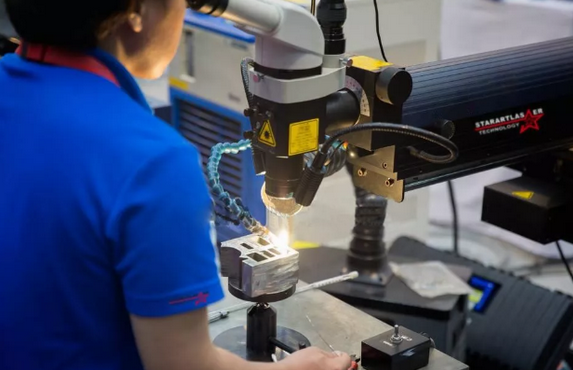
Plastic welding technology plays an increasingly important role in modern manufacturing. Compared to metal welding, plastic welding faces unique challenges and requirements due to differences in material properties. This article will delve into the basic principles of plastic welding, common methods, technical difficulties, and their solutions, providing valuable references for professionals engaged in plastic welding.
Basic Principles of Plastic Welding
Plastic welding refers to the process of melting two or more pieces of plastic material together through heating and pressure. The basic principle is to use thermal energy to increase the molecular chain activity of the plastic material, thereby achieving the bonding and curing of the plastic parts under certain pressure.
1.1 Thermoplastics
Thermoplastics are the most commonly used materials for welding. They soften and melt when heated and return to a solid state when cooled. These plastics include polyethylene (PE), polypropylene (PP), polyvinyl chloride (PVC), etc.
1.2 Thermosetting Plastics
Thermosetting plastics undergo a chemical reaction during heating, forming an insoluble and non-meltable solid structure. They are malleable during initial molding but do not melt after forming, making welding more difficult. These plastics include epoxy resins, phenolic resins, etc.
Common Methods of Plastic Welding
2.1 Hot Air Welding
Hot air welding involves using high-temperature airflow generated by a hot air gun to heat the plastic welding rod and base material, causing their surfaces to melt and bond together. This method is suitable for welding thicker plastic parts and is commonly used for materials like polyethylene and polypropylene.
2.2 Extrusion Welding
Extrusion welding melts the plastic welding rod through an extruder and extrudes it to the joint of the base material to achieve welding. This method is suitable for welding large plastic components, such as plastic pipes and storage tanks.
2.3 Ultrasonic Welding
Ultrasonic welding uses high-frequency mechanical vibration energy to generate heat at the contact surface, causing it to melt and weld the plastic parts. This method has advantages such as fast welding speed and small heat-affected zone, and is suitable for welding small plastic parts like electronic component casings.
2.4 Vibration Welding
Vibration welding generates heat through mechanical vibration and friction, causing the contact surface to melt and bond together. This method is suitable for welding larger areas and complex shapes, such as car dashboards and home appliance casings.
2.5 Laser Welding
Laser welding uses a laser beam as the heat source to melt the surface of the plastic material and bond it. This method has advantages such as high precision, high speed, and non-contact, and is suitable for welding precision plastic parts.
Technical Difficulties and Solutions in Plastic Welding
3.1 Material Selection
There is a wide variety of plastic materials with significant differences in physical and chemical properties. It is necessary to choose materials with good compatibility to ensure the strength and durability of the weld joints. Using welding rods made of the same or similar resin base can improve welding results.
3.2 Temperature Control
Plastic materials are very sensitive to temperature; too high or too low temperatures can affect weld quality. It is essential to precisely control the welding temperature to avoid material decomposition or insufficient melting. Modern welding equipment usually comes with precise temperature control systems to ensure stable weld quality.
3.3 Welding Pressure
Appropriate pressure must be applied during the welding process to ensure that the molten material fully contacts and bonds. Excessive pressure may cause the weld to be too thin or deformed, while insufficient pressure may result in an unreliable weld. Determining the optimal welding pressure through experimentation is key to improving weld quality.
3.4 Surface Treatment
The surface condition of plastic materials significantly affects weld quality. Before welding, the contact surfaces must be cleaned and pretreated to remove oil stains, dust, and oxidation layers, ensuring smooth welding. Chemical cleaning agents or mechanical polishing can be used for surface treatment.
Applications of Plastic Welding
4.1 Automotive Manufacturing
Plastic welding technology is widely used in automotive manufacturing for welding bumpers, dashboards, fuel tanks, etc. Through plastic welding, lightweight designs can be achieved, improving fuel efficiency and performance of vehicles.
4.2 Electronics and Appliances
In the electronics and appliances industry, plastic welding technology is used to manufacture casings and internal structural components for mobile phones, computers, home appliances, etc. Ultrasonic welding and laser welding are common methods that ensure weld accuracy and appearance quality.
4.3 Medical Equipment
Plastic welding technology is applied in the manufacturing of disposable syringes, infusion tubes, respirators, and other products in the medical equipment industry. Laser welding and ultrasonic welding have characteristics of no pollution and high precision, suitable for welding medical products with high hygiene requirements.
4.4 Construction and Piping
Plastic welding technology is used for welding plastic pipes, storage tanks, valves, and other products in the construction and piping fields. Extrusion welding and hot air welding are common methods that ensure the sealing and strength of the weld joints. Conclusion
Plastic welding technology is increasingly widely used across various industries. By mastering the welding techniques and solutions for different plastic materials, weld quality and production efficiency can be effectively improved. It is hoped that this discussion on plastic welding technology will provide valuable references and guidance for relevant professionals. In the future, with continuous advancements in material science and welding technology, plastic welding will showcase its unique advantages and broad application prospects in more fields.





 Customer service 1
Customer service 1  Customer service 2
Customer service 2